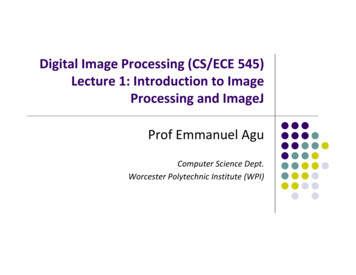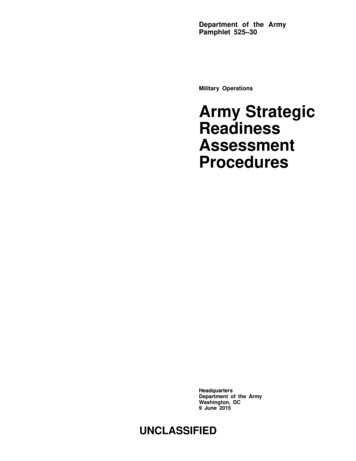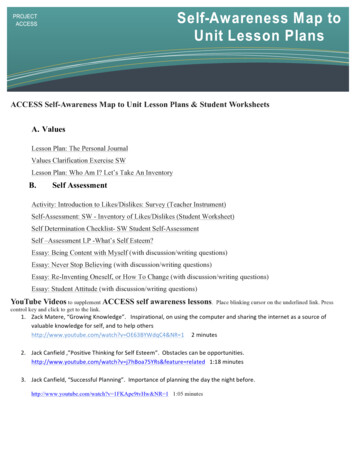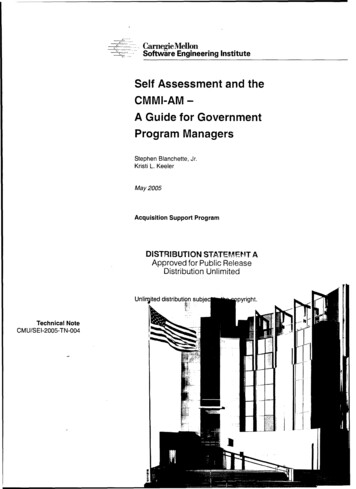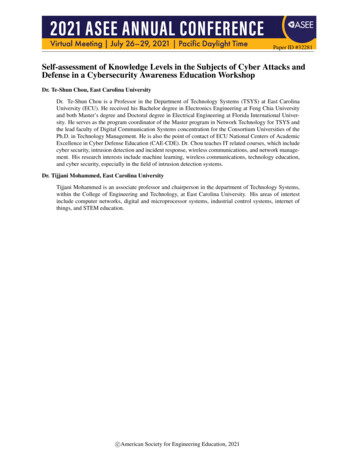
Transcription
Paper ID #32281Self-assessment of Knowledge Levels in the Subjects of Cyber Attacks andDefense in a Cybersecurity Awareness Education WorkshopDr. Te-Shun Chou, East Carolina UniversityDr. Te-Shun Chou is a Professor in the Department of Technology Systems (TSYS) at East CarolinaUniversity (ECU). He received his Bachelor degree in Electronics Engineering at Feng Chia Universityand both Master’s degree and Doctoral degree in Electrical Engineering at Florida International University. He serves as the program coordinator of the Master program in Network Technology for TSYS andthe lead faculty of Digital Communication Systems concentration for the Consortium Universities of thePh.D. in Technology Management. He is also the point of contact of ECU National Centers of AcademicExcellence in Cyber Defense Education (CAE-CDE). Dr. Chou teaches IT related courses, which includecyber security, intrusion detection and incident response, wireless communications, and network management. His research interests include machine learning, wireless communications, technology education,and cyber security, especially in the field of intrusion detection systems.Dr. Tijjani Mohammed, East Carolina UniversityTijjani Mohammed is an associate professor and chairperson in the department of Technology Systems,within the College of Engineering and Technology, at East Carolina University. His areas of intertestinclude computer networks, digital and microprocessor systems, industrial control systems, internet ofthings, and STEM education.c American Society for Engineering Education, 2021
Self-Assessment of Knowledge Levels in the Subjects of Cyber Attacks andDefense in a Cybersecurity Awareness Education Workshop
AbstractDuring the past couple of years, an online virtualized student-centric based learning system,Competitive Labs-as-a-Service (CLaaS), for cybersecurity education has been developed toprepare students with both theoretical knowledge and practical skills. The system included tenidentical learning environments that allowed for interaction among each environment, whichmade the learning system as a whole more like a realistic network environment. The systemcould be used in any cybersecurity related undergraduate and graduate courses. It would helpstudents understand the latest cybersecurity technologies. Furthermore, it would provide oncampus and distance education students with opportunities to learn and practice cyberattack andcyber defense techniques used in the real world.In order to maximize the positive impact of the system on cybersecurity education, a two-dayworkshop was held at East Carolina University (ECU) in the summer of 2019. The workshopwas hosted by the Department of Technology Systems (TSYS) and executed in a train-the-trainerformat. Nineteen college instructors from Southeast United States attended the workshop andparticipated in an exit survey. The survey included a set of categories each containing questionsto evaluate the workshop design and whether the participants thought the system would besuitable and helpful to students’ learning cybersecurity. Based on the survey outcomes, thedevelopment team could then make proper adjustments to improve the effectiveness of thesystem. In this paper, the design of the workshop was described. In addition, the paper discussedthe survey results and focused on the self-assessment of knowledge in the subjects ofcybersecurity category.Keywords: Cybersecurity; virtualization technology; cyberattack; cyber defense1. IntroductionHackers use a variety of skills to compromise systems in order to steal money, change data, ordestroy information. Cyberattacks pose serious threats and cause significant damage to privatecompanies and government agencies. For example, Yahoo suffered the biggest data breaches ofthe 21st century, in which one billion users’ accounts were comprised in 2013 and 2014 [1].Another example can be found from the City of Atlanta, Georgia. In March 2018, nearly all oftheir systems in the government of Jackson County, Georgia were locked and hacked by aransomware attack. The hack was the largest successful security breach of a major American cityby ransomware, which affected up to approximately 6 million people [2].Cyberattacks also target academic institutions. The latest one happened at Regis University inAugust 2019. The university reported that the outside malicious threat attacked their computersystems and shut down their website, phone lines, email services and online programs thatstudents use to submit work [3]. According to a study by Norton, cybercriminals will steal anestimated 33 billion records in 2023 [4]. Hence, cybersecurity in higher education has becomenot only important, but necessary to foster well-trained professionals to protect nationwidecomputer systems from cyberattacks.From 2017 to 2019, a team at ECU developed a cybersecurity learning system, CLaaS, based on
the need of our country for highly educated and skilled cybersecurity professionals. In order toprepare students with 21st century knowledge and skills related to cybersecurity, the system wasa combination of both cybersecurity theory and practical application in cybersecurity education.A variety of topics dealing with cyberattack and cyber defense were included in the system.These topics provided fundamental knowledge and best practices in cybersecurity that studentsneed in order to begin a comprehensive cybersecurity education.The system would help both our on-campus and distance education students to practice attackand defense techniques. It would also help other college students gain knowledge ofcybersecurity and awareness. Therefore, a two-day train-the-trainer workshop was organized inJuly 2019. A total of nineteen college instructors from fifteen colleges attended the workshop. Inthe workshop, the CLaaS was introduced and an exit survey was conducted. In this paper, we notonly introduced learning system and the workshop, but also discussed the survey and its results.This paper is organized as follows: Section 2 introduces the cybersecurity learning system. Section3 describes the recruitment. Section 4 illustrates the workshop. We then discuss the evaluation inSection 5 and the survey results in Section 6. Finally, we conclude our work in the last section.2. CLaaSThe system included multiple identical learning environments with virtual machines nested ineach environment to serve both tasks of attack and defense [5, 6]. The virtualized system mimicsa realistic network, providing real world experience while containing malicious network trafficwithin its boundaries. Each learner was given a learning environment. A graphic user interface(GUI) application was designed to provide access to the environment where cybersecurityactivities were performed [7].As shown in Figure 1, McAfee classified the network attacks into eight categories [8]. It isimpossible to introduce all of the cyber threats; however, we would like to cover as manycategories as possible and introduced the most important and current cybersecurity issues.Therefore, eight CyberSec activities were designed and each included two sub-labs: attack anddefense. Browser attacks and Scan categories: Web defacement labBrute force attacks and Scan categories: Secure remote login labDenial of service (DoS) attacks and Scan categories: FTP server DoS labWorm and Malware categories: Patch management and Backdoor labsWeb attacks and Scan categories: SQL injection (SQLi) labOthers and Scan categories: Honeypot and Secure plain text traffic labs
Figure 1. CyberSec labsA three-stage learning process was employed to help learners acquire knowledge of a certaintype of attack/defense [9]. Each attack/defense lab required learners to read an introduction ofthe attack/defense, pass a quiz, and then move on to the attack/defense instruction. Theinstruction included all the required information for launching the attack (or performing theprotection).Additionally, in order to encourage students to interact with others, the environment served as acompetition. Figure 2 shows the conceptual infrastructure diagram. Each learner owns a learningenvironment and acts as both attacker and defender. When acting as an attacker, learners will betaught to model the actions of the attacks to attack other learners within the learningenvironment. When acting as a defender, learners will be taught to identify system vulnerabilitiesand apply the appropriate mechanisms to harden the system.Objectives were included in each sub-lab. The learner who successfully completed an objectivegained one thousand points; on the contrary, the learner who did not properly implement adefense mechanism and was thus attacked by others consequently lost one thousand points. Inaddition, learners who successfully passed a quiz received ten points for each question. A Scoreand Message Board was implemented in the GUI application [10, 11]. When anattack/defense/quiz occurred, related messages were displayed on the Board. Figure 3 shows aphoto of the Board taken from the projector screen during the workshop.
Figure 2. The competition conceptual infrastructure diagramFigure 3. The Score and Message Board3. RecruitmentIn order to disseminate the system to other colleges who are interested in promotingcybersecurity education, a 2-day workshop was held in the summer of 2019. We opened twentyseats and used an online service [12] to design an application form for recruiting participants.The event information was distributed to both our Advisory Board of the Information ComputerTechnology (ICT) Program and the Cisco Academy Support Center. The seats were filled withinone day and nineteen attended the event. All the participants were from Colleges andUniversities in the Southeast region, which were a mix from North Carolina, South Carolina,Georgia, and Virginia. Among them, only two did not teach cybersecurity related courses. Inaddition, two guest speakers from the cybersecurity industry and three from academia wereinvited to give presentations about the latest technology and real-world cybersecurity issues.
4. WorkshopIn total, ten identical learning environments were created and two participants working as a teamwere given access to a learning environment for the duration of the workshop. The workshopwas coordinated by the project director with the assistance of one undergraduate and onegraduate student. This allowed every participant an opportunity to have questions answered andto get individual attention from the facilitators.The workshop covered the following topics: Details of the virtual online learning system for cybersecurity education, CLaaS, thatinclude the network topology, the method to access the environment, the usage of theGUI application, and the introduction of labsHands-on lab time to run through the cyberattack and cyber defense scenariosPresentations of guest speakers5. EvaluationAn evaluation was conducted at the end of the workshop and an online survey was designed byusing Google Forms [13]. Through the workshop attendees’ feedback, we hope issues such ascontent appropriateness, technical quality, and learner acceptability could be identified. Theproject members could then revise the system and content to improve the overall quality of thesystem.The survey questions were classified into four major categories. Examples of questions wereshown below. For each question a five-level Likert scale was used. Some questions’ responseswere “5 Excellent. 4 Very Good. 3 Good. 2 Fair. 1 Poor” and some were “5 StronglyAgree, 4 Agree, 3 Neutral, 2 Disagree, and 1 Strongly Disagree”. In addition, a few ofshort answers were included in the survey. Questions related to self-assessment of knowledge level in the subjects of cybersecurity(before and after attending the workshop).o Before attending this workshop, the degree of proficiency in the subject of vulnerabilityscanning is:o After attending this workshop, the degree of proficiency in the subject of passwordcracking techniques is: Questions related to the workshop.o The workshop content is relevant to the courses I teach.o The workshop guest speakers’ presentations were relevant and interesting to theworkshop objectives. Questions related to the learning environment.o The performance of the virtual machines in the labs was satisfactory.o The graphic user interface (GUI) was intuitive and easy to use. Questions related to the CyberSec labs.o The labs were relevant to current cybersecurity technology and methods.o I encountered no difficulties when doing the labs.
6. Survey ResultsThe survey was conducted at the end of the workshop. There were nineteen instructors thatattended the workshop and all of them completed the exit survey questionnaires, resulting in aresponse rate of 100%. In this paper, we focused on the discussion of the survey results regardingself-assessment of knowledge level in the subjects of cybersecurity (before and after). Additionalsurvey analysis will be shared in future papers.Eleven questions were designed to assess the participants’ knowledge level regarding thesubjects of eight CyberSec labs. Table 1 shows the questions and Figure 4 displays the surveyresults. Descriptive statistical techniques were used to tabulate the survey data. Table 2 exploresthe comparison between the pre- and post-assessment results of the workshop attendees.Table 1. Self-assessment of knowledge level in the subjects of cybersecurity (before and after)CategoryLabSurvey QuestionScan attackL1 - L8Q1. The degree of proficiency in the subject ofvulnerability scanning is:Browser andWeb attackL1. Web defacementL2. SQLiQ2. The degree of proficiency in the subject ofbrowser and web attacks is:Q3. The degree of proficiency in the subject ofbrowser and web defense is:Brute forceattackL3. Remote secure loginQ4. The degree of proficiency in the subject ofpassword cracking techniques is:DoS attackL4. FTP server DoSQ5. The degree of proficiency in the subject ofDoS attacks is:Q6. The degree of proficiency in the subject ofDoS protection mechanism is:Worm andMalwareL5. Patch managementL6. BackdoorQ7. The degree of proficiency in the subject ofpatch management is:Q8. The degree of proficiency in the subject ofremote backdoors is:Q9. The degree of proficiency in the subject ofprotecting against remote backdoors is:OthersL7. HoneypotL8. Secure plain texttrafficQ10. The degree of proficiency in the subject ofhoney pot is:Q11. The degree of proficiency in the subject ofsecuring remote authentication services is:
Table 2. Survey .24E-076.11E-096.25E-111.42E-05Figure 4. Survey results of self-assessment of knowledge levelin the subjects of cybersecurity (before and after)
When self-assessing the degree of proficiency in the subjects of cybersecurity before attendingthe workshop, the result of Q4 had the highest above good (excellent, very good, and good) rate(73.68%) and both Q8 and Q10 had the lowest above good rates (36.84%). We believed that thereason was because password cracking was a popular research subject. On the contrary,backdoors and honeypot were relatively uncommon compared to other cybersecurity topics. Theabove good rates fell within the range between 47.37% and 68.42% for the other nine questions.As for the responses to questions after attending the workshop, the respondents were satisfiedwith the learning outcome of backdoors, with both questions, Q8 and Q9, having the highestabove good rate (89.47%). Originally both Q8 and Q10 had the lowest above good rates beforeattending the workshop. After attending the workshop, these rates significantly jumped to89.47% and 78.95%, respectively. The overall average above good rate reached 82.30%.As shown in Table 2, the data was highly significant since the P-value was much less than 0.05.Before attending the workshop, the mean values of three questions, Q1, Q3, and Q7, were above3.0. After attending the workshop, the mean values of all the questions were above 3.0. Overall,respondents had very positive attitudes toward the workshop learning outcome and theyconcurred that the learning objectives have been achieved.In addition, a question was asked about why the workshop attendees were still unfamiliar withthe cybersecurity subjects the workshop covered after attending the workshop. The major reasonthe attendees were not able to complete all the tasks was due to the fact that the workshopcovered a broad of cybersecurity subjects. The attendees expressed that they needed more time toexplore and absorb all the contents.ConclusionsA two-day workshop was held at ECU in July 2019 in train-the-trainer format. Nineteen facultyfrom Colleges and Universities attended the workshop. The workshop introduced the learningsystem and provided the attendees with opportunities to practice the hands-on cybersecurity labs.At the end of the workshop, an exit survey was conducted to evaluate whether the system wassuitable and helpful to cybersecurity learning. This paper discussed the attendees’ selfassessment of knowledge level in the subjects of cybersecurity before and after attending theworkshop. The results discovered that respondents were pleased with the learning system. Thesystem had successfully provided an effective way to help participants in learning the subjects ofcybersecurity. Workshop attendees had gained a better understanding of different cybersecuritysubjects after attending the workshop. We believed our system could help college students gainawareness and basic knowledge of cyberattack and cyber defense.AcknowledgementsThis research is based upon work supported by the Secure &Trustworthy Cyberspace (SaTC)Program of the National Science Foundation under Grant Number 1723650. The authors aregrateful to the support of TSYS in the College of Engineering and Technology at ECU. Thanks
also go to our ICT Advisory Board and Mr. Kelly Caudle for their efforts to broadcast theworkshop recruitment information and those who attended the . Armerding, The 18 biggest data breaches of the 21st century, 2018. Retrieved -biggest-data-breaches-of-the-21st-century.htmlB. Freed, Georgia county paid 400K to ransomware hackers, 2019. Retrieved 0k-to-ransomware-hackers/D. Kobialka, Regis University Cyberattack: What You Need to Know, 2019. Retrieved you-need-toknow/Symantec, 10 cybersecurity facts and statistics for 2018, 2018. Retrieved dscape-thatyou-should-know.htmlT. S. Chou, “Multi-Learning Techniques for Enhancing Student Engagement in Cyber Security Education,”American Society for Engineering Education (ASEE) Annual Conference and Exposition, Tampa, FL, June2019.T. S. Chou, “An Interactive Learning System for Cyber Security Education,” The Conference for IndustryEducation Collaboration (CIEC), New Orleans, LA, January 2019.W. Hotalen and T. S. Chou, “A Multiplayer Peer-to-Peer Cyber Attack and Defense Infrastructure,” AmericanSociety for Engineering Education (ASEE) Annual Conference and Exposition, Salt Lake City, Utah, June 2018.McAfee Labs, McAfee Labs Threat Report, 2017. Retrieved p-quarterly-threats-sept-2017.pdfT. S. Chou, “Labs and Three-Stage Learning Process for a Cyber Security Learning System,” InternationalConference on Engineering, Science and Technology (IConEST), Denver, CO, October 2019.N. Hempenius, Te-Shun Chou, and Lee Toderick, “Automatic Collection of Scoring Metrics in CompetitiveCybersecurity Lab Environments,” The Conference for Industry Education Collaboration (CIEC), NewOrleans, LA, January 2019.N. Hempenius, T. S. Chou, and L. Toderick, “Cybersecurity Competitive Labs-as-a-Service: Automated Scoreand Message Board Design,” Lighting Talk, The Annual Conference on Information Technology Education(SIGITE), Fort Lauderdale, FL, October 2018.Online RSVP Service. Retrieved from: https://www.justrsvp.me/Google Forms. Retrieved from: https://www.google.com/forms/about/
Self-assessment of Knowledge Levels in the Subjects of Cyber Attacks and Defense in a Cybersecurity Awareness Education Workshop Dr. Te-Shun Chou, East Carolina University Dr. Te-Shun Chou is a Professor in the Department of Tec
